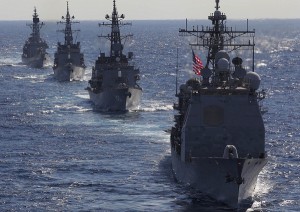
Conflict, Territorial Dispute, West Philippine Sea, South China Sea, Spratlys, Spratly Islands, China, Philippines, Asia
TAIPEI, Taiwan—When President Barack Obama arrives in Australia on Wednesday to kick off a four-day Asia-Pacific visit, he should receive a warm reception from America’s longtime allies in the region.
The US has deepened military ties with Asia in the past year, at once reassuring its partners of its commitment and capitalizing on mutual fears about China’s rise. Both sides face a simple truth: They need each other, possibly more than ever.
In Australia, Obama is expected to announce an agreement to allow an expanded US military presence in the country. Earlier this year, the US disclosed plans to deploy military ships to Singapore. And Malaysia has joined two multination military exercises with the US for the first time.
Such moves, together with frequent visits by senior American officials — Obama will be the first president to join an annual East Asian leaders meeting later this week — have defused fears that America’s defense presence might wane. They also show the region’s growing concern about China’s more aggressive stance in recent years.
“China is becoming an 800-pound gorilla,” said Ralph Cossa, president of Pacific Forum CSIS, a Hawaii-based think tank. “The US is still the 1,600-pound gorilla, so which one would you rather have? And we’re housebroken; we’re a lot more fun to invite into your living room than the one who isn’t.”
Since 2009, China has confronted Southeast Asian countries over rival territorial claims in the West Philippine Sea (South China Sea), refused to condemn North Korea’s apparent sinking of a South Korean naval vessel, and squared off with Japan over claims to a long disputed island group between Okinawa and Taiwan.
“Before this time there was extreme reluctance to anger Beijing by explicitly deepening ties with Washington,” University of Sydney security specialist John Lee said. “After 2010 there was little choice for other regional capitals but to seek closer relations with the US in order to balance and hedge against future Chinese intentions and behavior.”
China’s defense spending has increased threefold since the 1990s to about $160 billion last year, and its military has recently tested a new stealth jet fighter and launched its first aircraft carrier.
The core of America’s Asian security presence remains South Korea and Japan, which between them host some 80,000 US troops and several US Air Force and Navy bases. Japan is headquarters for the 7th fleet, America’s naval force in the Pacific.
Encouraged by clear signs of US resolve, the Northeast Asian allies have remained firmly on America’s side.
Cossa says South Korea was particularly impressed by the Obama administration’s decision to send the nuclear-powered supercarrier USS George Washington to the Yellow Sea as a show of force in the days following North Korea’s shelling of a South Korean island a year ago, and then send American troops to the island to observe military drills.
The Japanese Cabinet adopted guidelines late last year calling for an intensifying of the alliance, which the Japanese government says is “indispensable” to its security.
Even America’s rejection of Taiwan’s request for new F-16s this year was tempered by an agreement to upgrade its existing F-16 fleet, keeping the democratic island that China claims as its own at least nominally within the American security perimeter.
In Southeast Asia, Vietnam, the Philippines and Malaysia have all been at loggerheads with China over a number of tiny islands in the West Philippine Sea. China believes the Spratly and Paracel islands may sit astride large deposits of oil and gas — though others are doubtful — and has moved assertively to underscore its claims in the area since 2009.
The United States began to push back following U.S. Secretary of State Hillary Rodham Clinton’s implicit criticism of China’s behavior at a regional security forum in Vietnam in July 2010. It stepped up cooperation with regional allies and even began building a new security relationship with old enemy Vietnam.
In June of this year, then U.S. Defense Secretary Robert Gates said littoral combat ships, small vessels designed to operate close to shore, would be deployed to Singapore. The prosperous city-state sits astride the Straits of Malacca, the strategic waterway through which the majority of Asia’s oil imports pass, including those to China and Japan.
In the longer term, America’s soaring government budget deficits could influence its deployments in the region, with Pentagon cutbacks expected to total some $450 billion over the next decade — roughly the size of annual U.S. defense expenditures not including Afghanistan and Iraq.
But US Defense Secretary Leon Panetta, visiting Japan and Indonesia last month, dismissed speculation that the cuts would force America to trim its Asian profile. “We will … not only maintain but strengthen our presence in this part of the world,” he said. “We are a Pacific nation, we’ll have a Pacific presence.”
China could also face limits on its defense spending. If it can’t sustain its high economic growth rates, that could undermine its ability to compete with the US militarily.
“Of course if China keeps growing rapidly for two decades and America does not, then the balance of economic and military power will eventually shift,” said Lee, the University of Sydney specialist But “there are strong reasons to believe that China cannot keep growing at this rate with its current model.”